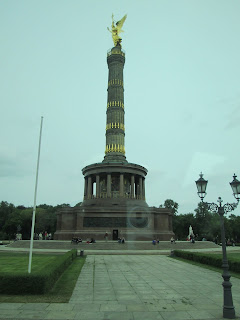Early Tuesday morning, we left the boat and boarded a bus for St. Petersburg (Sahkt Pee-TARE-borg). Even though St. Petersburg is the showplace -- and the most European city -- of Russia, we noticed immediately that the "non-tourist" parts of the city had a more drab look than anything we had seen in Europe.
Our tour actually started on the Fontanka River. In the picture below, our group is on the right (walking through a slight drizzle with their coats & umbrellas), heading for one of those long, squatty river boats.
The Fontanka is one of 93 rivers and canals in St. Petersburg and the reason for the "squatty" boats is that the bridges are only 2.5 meters (8 feet) above the waterline.
The front of the boat is covered and there are stairs down to the seating area. If you ride in the back of the boat (where I took all my pictures), however, you must watch for bridges. Even as short as I am (5' 6"), I could not stand up straight under most of the bridges.
As you can see in the pictures above, the Fontanka River is lined with the former private residences of the Russian nobility. Most of these buildings are used for museums, restaurants, and other purposes now. But you don't see the REAL wealth (or former wealth) of St. Petersburg until the Fontanka empties into the Neva River.
The famous Hermitage Museum, which boasts the largest collection of paintings in the world, is so huge that it can only be seen from the Neva River. The picture below is the old Winter Palace which is probably considered by some to be "the" Hermitage Museum, but...
...there are actually 5 buildings. The "New Hermitage" (which is located behind the Winter Palace above), the "Old Hermitage" (the yellow building below), the "Hermitage Theater" (only partially visible to the left of the yellow building below), "Small Hermitage" (to the right of the yellow building), and the "Winter Palace" (the picture above -- also the far right of the picture below).
Also, from the Neva River, it's easy to see "Senate Square" (the yellow building in the middle below), "St. Isaac's Cathedral" (the gold dome to the right of the yellow building), and their location in relationship to each other and the Hermitage (at the left in the picture below).
Next, we saw the INSIDE of the Hermitage. Even after our river tour, we were still able to arrive before the general public was admitted.
But, even arriving before opening time -- off season -- it was still VERY crowded inside. The museum has about 3 million visitors a year. Our 3-hour guided tour was definitely a huge sensory overload. My advice to hard-core art museum fans: take a couple of days to see it. My advice to everyone else: keep the tour under an hour. View the opulence in a few rooms...
...Go see Rembrandt's "Old Man in Red" (below) and maybe a couple of other famous paintings, then go take the "river tour."
We had lunch in an upscale restaurant. The building was fancy (I think it was formerly a noble's mansion), but the food was quite plain.
After lunch, we visited "The Church of the Savior on Spilled Blood." It's not the Savior's blood they're commemorating, however -- Alexander II was mortally wounded here.
The inside walls and ceilings are entirely covered by mosaics.
Our last stop of the day was St. Isaac's Cathedral. As I mentioned earlier, it's almost impossible to get a good view of many of the sights from up close (as demonstrated by the picture below). However, you can match the gold dome below with the gold dome in the last Neva River picture above.
We returned to the boat for dinner, but our fun wasn't over. The best part of the whole St. Petersburg experience, in my opinion, was that evening. We boarded another bus after dinner and headed back to the city for a "Folkloric Show" -- traditional Russian music, singing, and dancing. Because of the stage lights, I wasn't able to get many good pictures, but it was the highlight of the day.




























































